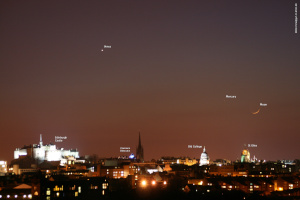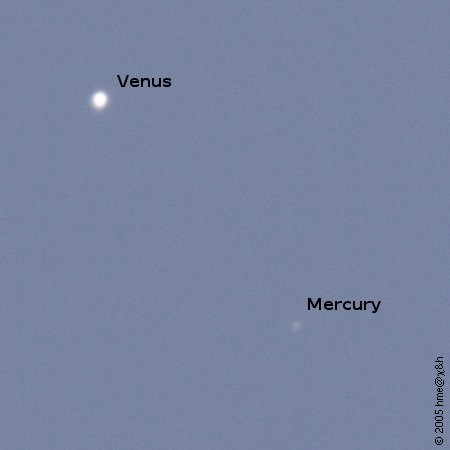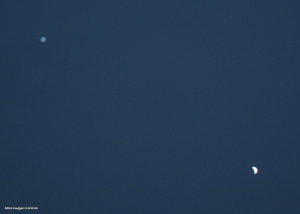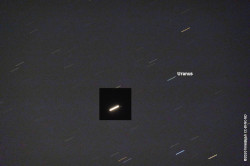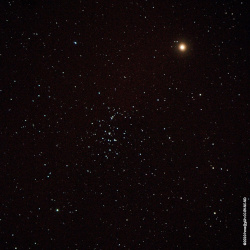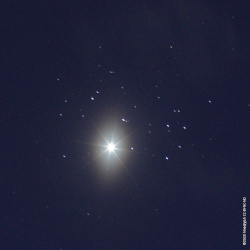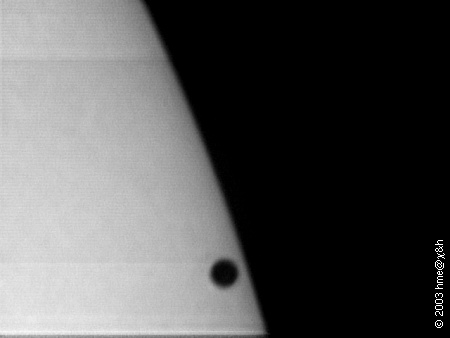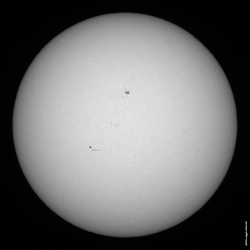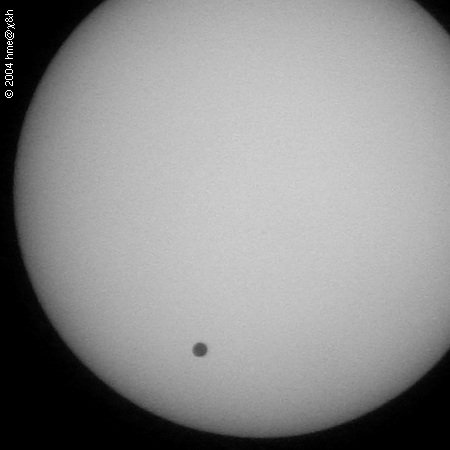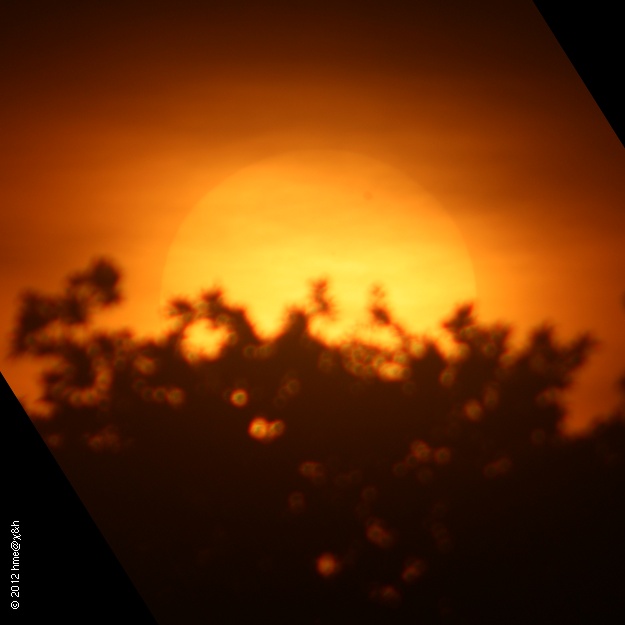
{ Practical astronomy | Astronomy | Planets | Conjunctions }
Conjunctions
Really well defined is the term conjunction only in the context of synodic orbits of the planets. There, conjunction is the point in time when the Sun and the planet have the same ecliptic longitude or the same right ascension. In contexts where we might want to get out our cameras, the term is not so well defined. A conjunction involves one or more planets. At least two objects have to be involved, the second can be a planet or a star. The distance between the objects has to be "small". We exclude here the Moon as conjoining object, the section about the Moon has its own subsection about conjunctions.
In a close conjunction, two planets might be only a few arc minutes apart and would both fit into the high-magnification field of view of a telescope. But a few degrees might be close enough, if naked-eye observation or wide-field imaging is involved, or if more than two planets are involved. A close conjunction will last only a few hours, while a wider conjunction could involve two planets making their opposition loop in the same region of the sky, which can take weeks.
Although the conjoining objects may appear very close to each other on our sky, they are at very different distances; there is no danger of them colliding.
For a wide conjunction you need a wide enough field of view. This is most likely a light tele lens and the camera mounted on a tripod. Exposures are a few seconds. It does not matter too much if the stars and planets begin to trail, but if the Moon is involved you do not want its phase to be smeared out. An advantage of a stationary camera is that you can include some landscape.
Image parameters:
- Mount: stationary on tripod
- Lens: 55–200 mm zoom tele lens
- Focal length: 78 mm, f/4.5
- Camera: Canon EOS 400D
- Field of view: 17°×11°
- Filters: none, automatic white balance
- Exposure: 4 s at 400 ISO
- Processing: none
- Location: Edinburgh
Rarely come two planets very close together and can be seen in the same field of view in the telescope. In the upper image, Venus and Mercury are only 4' apart. Such proximity does not last long, which is why this image was taken during the day; a few hours earlier or later the planets would be significantly further apart. The lower image shows a similar situation, where Jupiter and Venus are 0.4° apart.
Image parameters (upper image):
- Mount: equatorial, tracking
- Telescope: Celestron 8, 200 mm Schmidt-Cassegrain; with 2× adapter
- Focal length: 3500 mm, f/17.5
- Camera: Canon EOS 300D
- Field of view: 5'
- Filters: none, outdoor/Sun white balance
- Exposure: 1.6 ms at 400 ISO
- Processing: raw data with logarithmic stretch
- Location: Edinburgh
Image parameters (lower image):
- Mount: equatorial, tracking
- Telescope: Celestron 8, 200 mm Schmidt-Cassegrain
- Focal length: 2000 mm, f/10
- Camera: Canon EOS 600Dα
- Field of view: 0.5°
- Filters: CLS-visual light pollution filter, Hα enhancement filter, outdoor/Sun white balance
- Exposure: 2 ms at 800 ISO
- Processing: none
- Location: Edinburgh
This image was taken with rather simple equipment, a travel-zoom compact camera and tripod. The exposure could be shorter: Once the stars trail, the exposure will not detect fainter stars, but the sky background will continue to brighten. The original exposure (as still shown in the area around Jupiter) does in fact not show most of the stars or the background. A linear stretch is applied to brighten the image five-fold (whole area excluding Jupiter). These star trails have a pleasing length; the show much better the colour of the stars than a tracked or guided exposure would.
Image parameters:
- Mount: stationary on tripod
- Lens: Panasonic Lumix TZ8 at 12× zoom
- Focal length: 49 mm, f/4.9
- Camera: Panasonic Lumix TZ8
- Field of view: 7°×5°
- Filters: none, outdoor/Sun balance
- Exposure: 60 s at 100 ISO
- Processing: none near Jupiter; linear stretch elsewhere
- Location: Isle of Bute
Two bright open star clusters, M44 and M45, lie near the ecliptic, so that the Moon and planets pass near them on occasion. The upper image is a long, tracked exposure. The lower image is taken with a stationary camera and only a few seconds exposure to keep the star trails short. In turn, the ISO is set to a higher value. The focal lengths and fields of view are broadly similar.
Image parameters (upper image):
- Mount: equatorial, tracking
- Lens: 135 mm zoom lens
- Focal length: 135 mm, f/4
- Camera: Canon EOS 400D
- Field of view: 5°
- Filters: none, outdoor/Sun white balance
- Exposure: 100 s at 400 ISO
- Processing: raw data with logarithmic stretch
- Location: Edinburgh
Image parameters (lower image):
- Mount: stationary on tripod
- Lens: 55–200 mm zoom tele lens
- Focal length: 200 mm, f/8
- Camera: Canon EOS 700D
- Field of view: 2.5°
- Filters: none, outdoor/Sun white balance
- Exposure: 5 s at 1600 ISO
- Processing: none
- Location: Edinburgh
Transits
Mercury and Venus, in their inferior conjunctions usually pass north or south of the Sun. If the conjunction happens at the time of year when the planet is crossing the ecliptic, then a transit occurs. The planet will move in front of the Sun and appear as a black, circular silhouette against the bright Sun. The transit lasts a number of hours.
Mercury transits occur at intervals of three to 13 years, in May or November. There are transits in 2003, 2006, 2016, 2019 and 2032. Venus has pairs of transits 8 years apart, in June or December. More than 100 years pass between pairs. The most recent pair occurred in 2004 and 2012. The next pair will be 2117 and 2125.
The upper image is taken in 2003 with the narrow field of view of a webcam behind a large telescope. In contrast, the lower image shows the whole Sun in the moderate field of view of a smaller telescope with a larger camera detector.
Image parameters (upper image):
- Mount: equatorial, tracking
- Telescope: Celestron 8, 200 mm Schmidt-Cassegrain; with 2× adapter
- Focal length: 3500 mm, f/17.5
- Camera: Philips ToUcam Pro
- Field of view: 3'
- Filters: Solar Skreen filter
- Exposure: webcam video, stacked
- Location: Edinburgh
Image parameters (lower image):
- Mount: equatorial without tracking
- Telescope: Telementor II, f/13.3 refractor
- Focal length: 840 mm, f/13.3
- Camera: Canon EOS 600Dα
- Field of view: 0.6°
- Filters: Baader AstroSolar filter, CLS-visual light pollution filter, Hα enhancement filter
- Exposure: 4 ms at 100 ISO
- Processing: green for grey, raw data with linear stretch
- Location: Osera, Aragón
The 2004 Venus transit occurred during daytime in Europe, but the 2012 transit was visible only during the final hour or two from Europe. As the Sun rises sooner further east, I travelled from Scotland to Germany to observe it. The weather was not good, but better than back home.
It appeared to me that cloud was too thick after the first minute of the Sun emerging from the distant treetops. I took images anyway, and close inspection of them allowed me to measure the distance of Venus from the solar limb in some of them. The results are mildly sensitive to the ratio of the Earth's size and the dimensions of the Solar System. Thus I was able to determine the astronomical unit – the mean distance between Earth and Sun – to be 143 ± 10 Gm. Even in 1761 and 1769, the concerted effort of the planet's astronomers did better at 153 Gm; the modern value is 149.59 Gm.
Image parameters (upper image):
- Mount: equatorial, tracking
- Lens: 400 mm tele lens
- Focal length: 400 mm, f/6.3
- Camera: Canon EOS 300D
- Field of view: 0.4°
- Filters: Baader AstroSolar filter
- Exposure: 2 ms at 400 ISO
- Location: Edinburgh
Image parameters (lower image):
- Mount: equatorial, tracking
- Lens: 400 mm tele lens; with 2× adapter
- Focal length: 800 mm, f/12.6
- Camera: Canon EOS 400D
- Field of view: 0.6°
- Filters: none
- Exposure: 0.25 ms at 100 ISO
- Processing: none
- Location: Heilshorn, Lower Saxony
